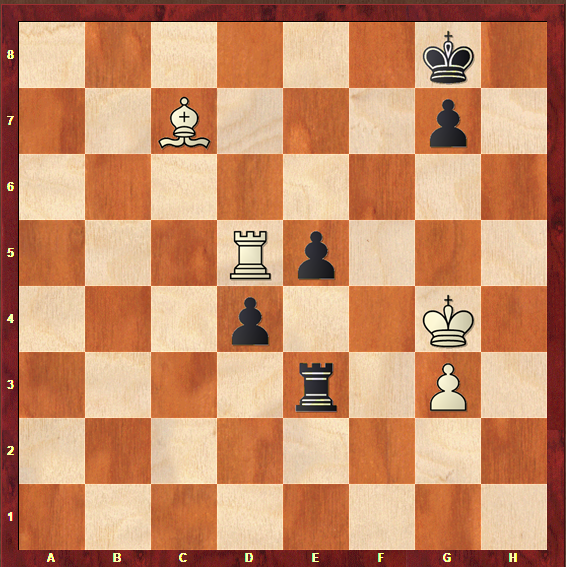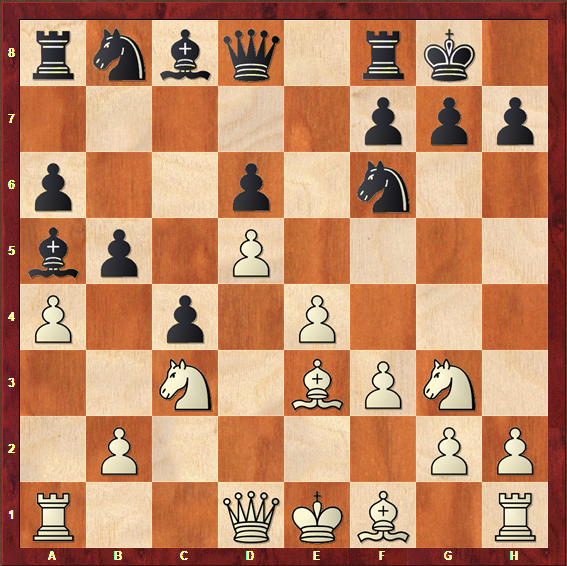Dear WordPress spellchecker: How is “Magnus” not a word???
Sincerely,
A passionate chess player!
Today is November 30th. It’s my aunt’s birthday (yes, it actually is). And it’s also Magnus Carlsen’s birthday! In honor of the occasion (Carlsen’s not my auntie’s, sorry auntie), I decided to thumb through Carlsen’s games – particularly his endgames. I was looking for interesting material from which I could learn something myself. I was especially curious to explore some of his games when he was younger. We all know more or less how he plays these days, and I thought it would be interesting to see how he played back when he was around my rating… Would I be able to relate? Would I understand his great moves as well as his mistakes? Would I make his mistakes and would he have made mine?
What did I find? I found a few instructive fails, though of course everyone has those. At one point I came across an interesting endgame that gave me a “flashback”.

Black to play
Before I go any further, ask yourself the following question: is white winning? Just answer intuitively.
The correct answer is yes! Though white has no immediate win, black has no fortress. Take a look at how an 11-year-old Carlsen wins this endgame flawlessly.
This reminded me of a game of mine which wasn’t that simple. Actually, it wasn’t simple at all! Seeing the Carlsen’s game prompted me to revisit it. The position is similar to the one above, yet is very different. There is no clear win, not even a verdict. And yeah, I was sitting on the wrong side…
Balakrishnan, Praveen (2456 USCF) — Brodsky, David (2405 USCF) US Cadet Championship 2016

Is white winning? Probably not, though it isn’t as drawn as you may think… I say “probably” because I have no “official” verification that it is a draw… It goes without saying that fortresses aren’t one of the strong points of engines, and there are way too many pieces on the board for tablebases to be of any use. Unfortunately, the game continuation did not help the “theoretical” is-this-winning debate due to a serious mistake on my part. However, I do not see how white can crack through the “best” defensive setup.
I played 31… h5 making loft for my king. 31… g6? looks suicidal on account of 32.Bc3 ideas, and 31… h6 was also playable. I chose h5, however, because I wanted to prevent white’s kingside expansion, or at least slow it down by forcing him to trade pawns. Praveen played 32.Rb7 tying my king down to the defense of the f7-pawn. I didn’t like 32… f6 on account of 33.Re7, hitting the newly-created weakness on e6. However, that’s what I should have done – as you’ll see in the game, white got a much better version of this. Playing committal moves like 32… f6 are hard, especially in such an early stage of the endgame.
Instead, I danced for the next few moves and let white get into position. The game went 32… Ra1+ 33.Ke2 Rg1 34.Kf2 Rd1 35.Bc3 Rc1 36.Be5 Rc2+ 37.Kg3

Here, I was getting a little too worried about white’s setup and decided to play 37… f6. Looking back at the starting position, my “concession” with f6 was much smaller. First of all, the white king is better-placed now. Second of all, I’ll have trouble playing Kh7-g6 because of Bxf6 ideas (the g7-pawn is pinned).
The game continued 38.Bb2 h4+ 39.Kh3 Rc4 40.g3 hxg3 41.hxg3 Re4 42.Kg4 Re3 43.Bd4 Rd3 44.Bc5 Rc3 45.Bd6

I’ve managed to trade a pair of pawns, but white’s position looks menacing. Black’s best move is 45… Kh7!. The detail I missed was that after 46.Bf8, which seems to win the g7-pawn, black has 46… Rc8! the idea being that the white bishop is pinned after 47.Bxg7? Rg8. White can (and should) naturally try something other than Bf8, but black should breathe a sigh of relief that his king escaped off the back rank. White, however, has resources, and I’m not quite confident enough to declare it a draw, but I believe it should be one.
Instead, I panicked and made the losing move 45… d4?. After 46.Rd7! black is busted because the d4-pawn will fall. The game went 46… Re3 47.Bc7 e5 48.fxe5 fxe5 49.Rd5

We can all agree that black is busted here. I resigned a few moves later.
What’s the moral of the story? First of all, not everything that looks like a fortress is a fortress! And even some of the fortresses have gray areas… My first misstep was not playing f6 earlier in the game – when I finally did play f6, white was much better off. Things got dicey, and one awful mistake was all it took for me to lose.
This is how Magnus Carlsen, Praveen, and many other players win better endgames. Their opponents miss “clean” draws, and things get progressively worse and worse until they can’t bare the pressure anymore and crack. This is an example of me cracking under the “Magnus Effect”. Many players used this strategy before Magnus Carlsen and many will use it after him, but he sure is the current king of this phenomenon.
Happy birthday, Magnus!
Anyway, until next time!




































